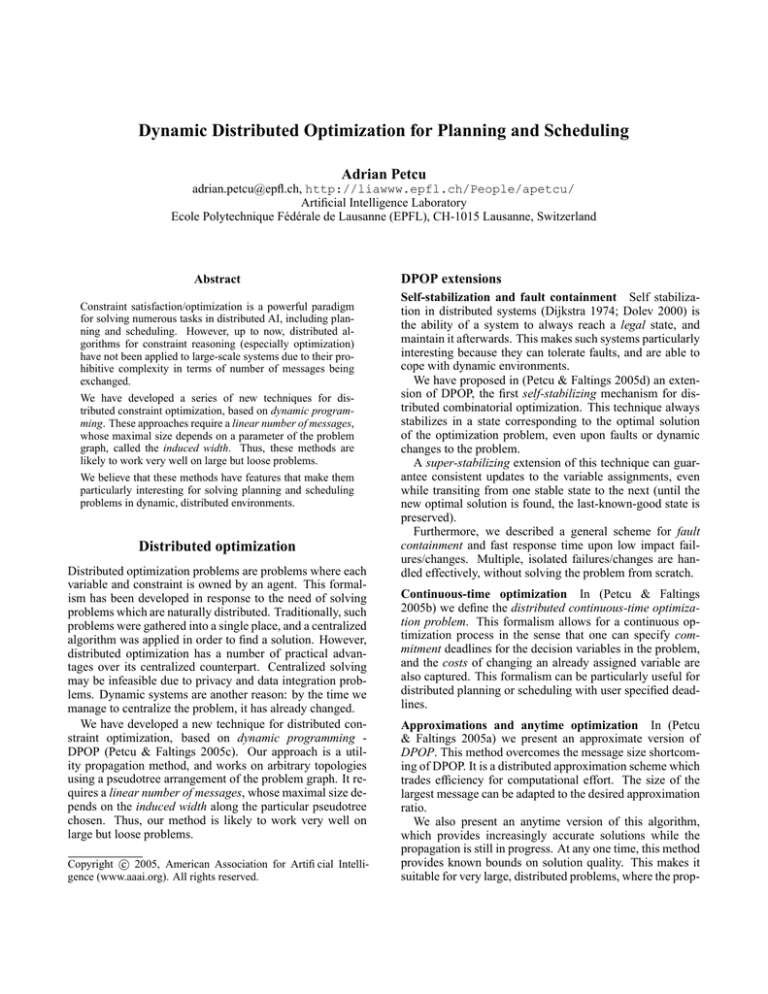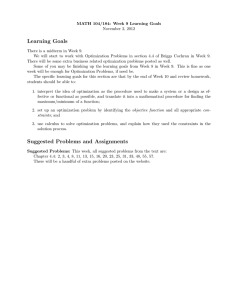
Dynamic Distributed Optimization for Planning and Scheduling
Adrian Petcu
adrian.petcu@epfl.ch, http://liawww.epfl.ch/People/apetcu/
Artificial Intelligence Laboratory
Ecole Polytechnique Fédérale de Lausanne (EPFL), CH-1015 Lausanne, Switzerland
Abstract
Constraint satisfaction/optimization is a powerful paradigm
for solving numerous tasks in distributed AI, including planning and scheduling. However, up to now, distributed algorithms for constraint reasoning (especially optimization)
have not been applied to large-scale systems due to their prohibitive complexity in terms of number of messages being
exchanged.
We have developed a series of new techniques for distributed constraint optimization, based on dynamic programming. These approaches require a linear number of messages,
whose maximal size depends on a parameter of the problem
graph, called the induced width. Thus, these methods are
likely to work very well on large but loose problems.
We believe that these methods have features that make them
particularly interesting for solving planning and scheduling
problems in dynamic, distributed environments.
Distributed optimization
Distributed optimization problems are problems where each
variable and constraint is owned by an agent. This formalism has been developed in response to the need of solving
problems which are naturally distributed. Traditionally, such
problems were gathered into a single place, and a centralized
algorithm was applied in order to find a solution. However,
distributed optimization has a number of practical advantages over its centralized counterpart. Centralized solving
may be infeasible due to privacy and data integration problems. Dynamic systems are another reason: by the time we
manage to centralize the problem, it has already changed.
We have developed a new technique for distributed constraint optimization, based on dynamic programming DPOP (Petcu & Faltings 2005c). Our approach is a utility propagation method, and works on arbitrary topologies
using a pseudotree arrangement of the problem graph. It requires a linear number of messages, whose maximal size depends on the induced width along the particular pseudotree
chosen. Thus, our method is likely to work very well on
large but loose problems.
c 2005, American Association for Artificial IntelliCopyright gence (www.aaai.org). All rights reserved.
DPOP extensions
Self-stabilization and fault containment Self stabilization in distributed systems (Dijkstra 1974; Dolev 2000) is
the ability of a system to always reach a legal state, and
maintain it afterwards. This makes such systems particularly
interesting because they can tolerate faults, and are able to
cope with dynamic environments.
We have proposed in (Petcu & Faltings 2005d) an extension of DPOP, the first self-stabilizing mechanism for distributed combinatorial optimization. This technique always
stabilizes in a state corresponding to the optimal solution
of the optimization problem, even upon faults or dynamic
changes to the problem.
A super-stabilizing extension of this technique can guarantee consistent updates to the variable assignments, even
while transiting from one stable state to the next (until the
new optimal solution is found, the last-known-good state is
preserved).
Furthermore, we described a general scheme for fault
containment and fast response time upon low impact failures/changes. Multiple, isolated failures/changes are handled effectively, without solving the problem from scratch.
Continuous-time optimization In (Petcu & Faltings
2005b) we define the distributed continuous-time optimization problem. This formalism allows for a continuous optimization process in the sense that one can specify commitment deadlines for the decision variables in the problem,
and the costs of changing an already assigned variable are
also captured. This formalism can be particularly useful for
distributed planning or scheduling with user specified deadlines.
Approximations and anytime optimization In (Petcu
& Faltings 2005a) we present an approximate version of
DPOP. This method overcomes the message size shortcoming of DPOP. It is a distributed approximation scheme which
trades efficiency for computational effort. The size of the
largest message can be adapted to the desired approximation
ratio.
We also present an anytime version of this algorithm,
which provides increasingly accurate solutions while the
propagation is still in progress. At any one time, this method
provides known bounds on solution quality. This makes it
suitable for very large, distributed problems, where the prop-
agation may take too long to complete.
Experimental evaluation
We experimented with distributed meeting scheduling in an
organization with a hierarchical structure (a tree with departments as nodes, and a set of agents working in each department). Random meetings are generated, each with a certain
utility for each agent. The objective is to find the schedule
that maximizes the overall utility.
We solved problems with up to 200 agents, 101 meetings,
270 variables, 341 constraints. To our knowledge, these are
by far the largest optimization problems solved with a complete, distributed algorithm. Previously, (Maheswaran et al.
2004) reported on experiments with 33 agents, 12 meetings,
47 variables, 123 constraints. They use a static optimization
algorithm, without any of the features that we describe here.
To our knowledge, there are no other results on selfstabilizing, fault-containing, continuous-time or approximate distributed optimization as yet.
Applications to planning and scheduling
There are obvious examples of applications of our techniques to planning and scheduling. Settings where privacy
is an issue (meeting scheduling, combinatorial auctions in
multiple markets, etc) lend themselves well to distributed
optimization methods.
Superstabilization can be vital in some settings: e.g.
while controlling an industrial process in real-time, random
settings applied to various installations during the search for
the optimal solution can be dangerous. Generating random
schedules/plans while searching for the optimal one can be
costly.
Fault containment: low impact perturbations on a dynamic system require just a few messages to reach the new
optimal state. In the best case, our system can deal with n
simultaneous perturbations in O(1) time. This leads to fast
response time in planning/scheduling applications, when
small perturbations are applied.
Continuous optimization as described in (Petcu & Faltings 2005b) can be used as a framework to deal optimally
with a continuous planning or scheduling process, in which
decisions have to be made under time constraints, and then
revised as new events unfold.
Approximations like (Petcu & Faltings 2005a) can be the
only way to deal with large multiagent systems, where centralization is not feasible and the required time and space
resources are not available. In such a setting, a configurable
anytime algorithm provides increasingly good solutions as
time goes by, with a predefined maximal amount of effort.
We have already studied the behavior of our techniques on
distributed meeting scheduling problems, and the results are
very promising. Currently, we are investigating their application to more general and difficult planning and scheduling
problems. Certain combinations of the techniques described
here can be particularly efficient in solving a number of realworld problems. We intend to pursue this research avenue
and identify such problems and settings where these tech-
niques perform well, as well as understanding their limitations.
References
Dijkstra, E. W. 1974. Self stabilizing systems in
spite of distributed control. Communication of the ACM
17(11):643–644.
Dolev, S. 2000. Self-Stabilization. MIT Press.
Maheswaran, R. T.; Tambe, M.; Bowring, E.; Pearce, J. P.;
and Varakantham, P. 2004. Taking DCOP to the realworld: Efficient complete solutions for distributed multievent scheduling. In AAMAS-04.
Petcu, A., and Faltings, B. 2005a. Approximations in distributed optimization. Technical Report 2005018, EPFL,
Lausanne,Switzerland.
Petcu, A., and Faltings, B. 2005b. Optimal solution stability in continuous time optimization. In IJCAI05 - Distributed Constraint Reasoning workshop, DCR05.
Petcu, A., and Faltings, B. 2005c. A scalable method
for multiagent constraint optimization. In Proceedings of
the 19th International Joint Conference on Artificial Intelligence, IJCAI-05.
Petcu, A., and Faltings, B. 2005d. Superstabilizing, faultcontaining multiagent combinatorial optimization. In Proceedings of the National Conference on Artificial Intelligence, AAAI-05.



